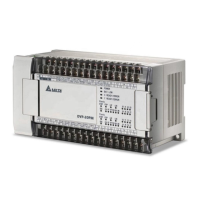3 Devices
goes from high to low, the motor will rotate for a specific number of PG0 pulses, or rotate for a
specific number of supplementary pulses, and then stop whether the its speed is V
CR
.
If the number of PG0 pulses is 0, and the number of supplementary pulses is 0, the motor used will
stop after DOG’s signal is generated and there is a transition in DOG’s signal from high to low.
Number of PG0 puls es
Number of supplementary pulses
Away from DOG's signal
Close to DOG's signal
Direction in which the axis
specified returns home
Velocity (PPS)
DOG
V
CR
V
CR
V
RT
Bit [9:10] in D1816 (D1896, D1976) is 11. The mode of returning home is an overwrite mode, and
the return to home is not triggered by a transition in DOG’s signal from high to low.
Steps: The motor used rotates at the speed V
RT
. When DOG’s signal is generated, the speed of the
motor begins to decrease to the speed V
CR
. After the motor rotates for a specific number of PG0
pulses, or rotate for a specific number of supplementary pulses, it will stop.
If the number of PG0 pulses or the number of supplementary pulses is not large, the speed of the
motor used will decrease to the speed V
CR
after DOG’s signal is generated. After the motor rotates
for a specific number of PG0 pulses, or rotates for a specific number of supplementary pulses, it will
stop whether its speed is V
CR
.
If the number of PG0 pulses is 0, and the number of supplementary pulses is 0, the motor used will
stop after DOG’s signal is generated.
Number of PG0 pul ses
Number of supplementary pulses
Away from DOG's signal
Close to DOG's signal
Direction in which the axis
specified returns home
Velocity (PPS)
DOG
V
CR
V
CR
V
RT
8. Bit 11 in D1816 (D1896, D1976): Direction in which the motor used rotates
Bit 11=0: When the motor rotates clockwise, the value indicating the present command position of
the axis specified increases.
Bit 11=1: When the motor rotates clockwise, the value indicating the present command position of
the axis specified decreases.
DVP-20PM Application Manual
3-51

